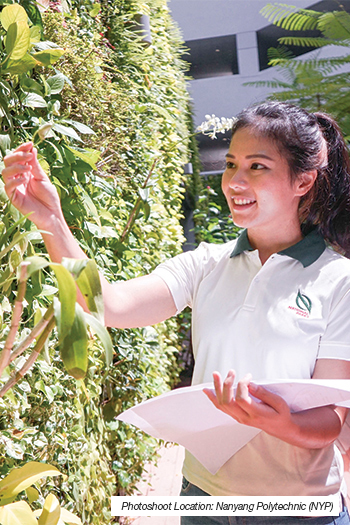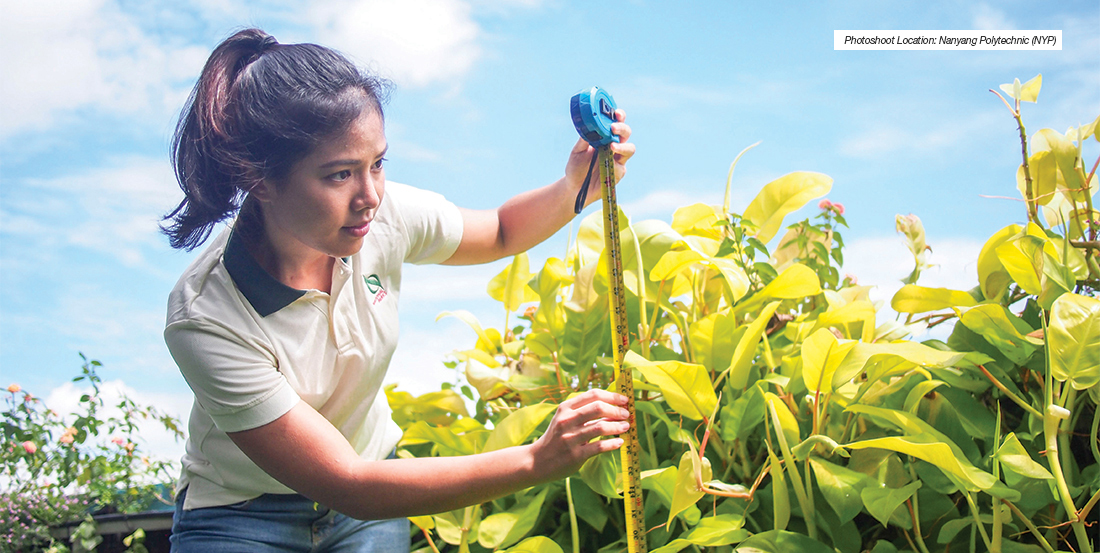As we continue to pursue progress, Singapore will remain at the centre of rapid urbanisation. And yet, even with the skyscrapers popping up and new roads being laid, there will be no shortage of greenery in our country.
With the vision of City in a Garden in mind, NParks has committed its efforts towards enhancing the greenery in our metropolis through initiatives such as the Skyrise Greenery Programme. We speak to Isis Lim, NParks Scholar and current Manager of said programme, to find out more about her role in achieving sustainable urban agriculture.
Why did you decide to take up the NParks Overseas Undergraduate Scholarship?
Isis Lim: From parks and nature reserves to our tree-lined roads, I have always been fascinated by the green spaces in Singapore. So I wondered how I could contribute towards conserving our natural heritage, while convincing others that it is important to do so as well. By being an NParks Overseas Undergraduate Scholar, I could do exactly what I wanted by playing a direct role in realising our City in a Garden vision.
Tell us about the opportunities you received under your scholarship.
Isis: I studied Forest Science and Marine Science at Australian National University (ANU). These topics are traditionally science-focused, but ANU actually took an inter-disciplinary approach. This meant that I was pushed to go beyond understanding the bio-physical aspects, where I also had to analyse various issues within a socio-economic context. The holistic nature of undergraduate learning at ANU broadened my perspectives on the management of our environment and ecosystems.
In my final year, I was given the opportunity to conduct field research in Ningaloo, Western Australia, to explore the relationships between a fish population and its changing habitat. NParks was very supportive of this endeavour and the research has since been published in Ecosphere – an international peer-reviewed scientific journal! I gained valuable skills in critical thinking and in presenting complex data in a clear and concise manner through this experience. Learning about how dynamic and varied nature can be, across scales of time and space, also provided me with a refreshing take on being adaptable and resilient.

Lim Ee Mei Isis
NParks Overseas Undergraduate Scholar
Manager, Skyrise Greenery
Share with us some details about Singapore’s greening strategies.
Isis: Our greening strategies are key to making Singapore a more liveable city. Faced with limited land, a growing population, and a premium for green spaces, Skyrise Greenery has emerged as an effective solution to create seamless and pervasive greenery across our island.
Since the start of the Skyrise Greenery Programme in 2009, there has been significant progress which has opened up many possibilities for greening our built environment. We have seen greenery incorporated into Singapore’s urban landscape in a variety of ways: from roof gardens and sky terraces, to landscaped balconies and green walls. Skyrise Greenery involves multiple stakeholders taking ownership of their own green spaces: from private home owners and developers, to the public sector. The collaboration involved with greening Singapore has been very encouraging, especially because it brings greenery closer to everyone.
To date, we have observed a total of 80.5 hectares of rooftop greenery in Singapore. Given that many other pioneering cities in the green roof scene had a much earlier head start, this is a remarkable achievement that has placed our city as one of the leaders in the world for Skyrise Greenery.
What unique opportunities can aspiring NParks scholars look forward to?
Isis: Work in NParks is diverse and dynamic. Every project is different and will present a whole range of learning experiences. With the upcoming park developments like Jurong Lake Gardens and Thomson Nature Park, and a range of species recovery programmes under the Nature Conservation Masterplan, NParks scholars can look forward to getting involved in developing new green spaces for recreation as well as conservation.
They can also expect to work with other agencies as NParks plays a crucial role in major inter-agency developments. Take Tengah for example – an upcoming “Forest Town”, which places a greater emphasis on greenery to create a quality living space in Singapore.
What qualities are needed for NParks scholars to do well in their career?
Isis: Having worked at NParks for two years, I feel that it is of utmost importance to find meaning in the work we do. For me, it is knowing that every effort I make contributes towards transforming Singapore into a City in a Garden.
It also helps to keep an open mind, have empathy with people you interact with, and be game to face challenges along the way.
What advice do you have for those exploring their scholarship options?
Isis: It may feel overwhelming and daunting to make a decision about further education and career options right after finishing your ‘A’ Levels. But if nature and green spaces interest you, you can find a rewarding career at NParks where you will be able to see the fruits of your labour! Just take the plunge and do what you feel most passionate about; the scholarship can and will open many doors for new opportunities and experiences.

